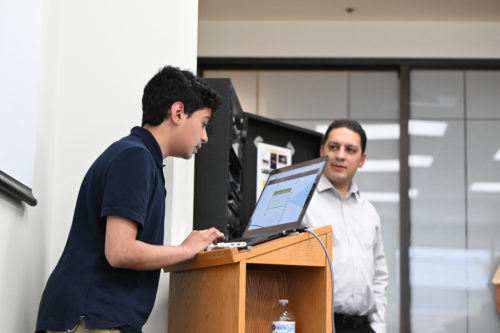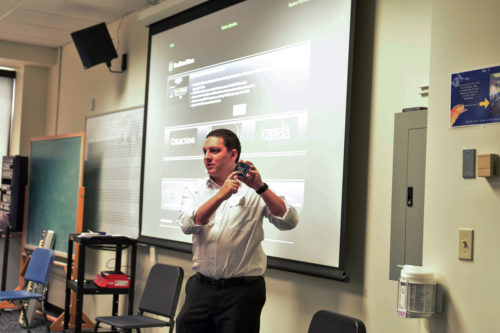Anthony DiBiase, a 14-year-old from the Hilton School District, stood in front of a group of high school students and their parents on Friday, July 19 at Eastman School of Music’s Institute for Music Leadership (IML) and pressed play on a laptop. A dreamy, nostalgic electronic work he called “Go” sounded over the speakers, which seized on digitalized sounds such as synthesized beats, samples of acoustic instruments, and even the “musique concrète” sounds (recorded environmental sounds) of a rewinding cassette tape in the middle—an intense moment that added structure to his overall composition.

Anthony Dibiase, a 14-year-old in the Hilton School District, shares a composition he created during the Institute for Music Leadership’s Future Leaders of Music Technology Camp in July 2024. Photo by Anna Reguero.
DiBiase was one of 16 students enrolled in the IML’s Future Leaders of Music Technology, a free, one-week camp from July 15-19 for high school aged kids across Rochester in grades 9-12—targeting Rochester city school students, but that ultimately brought students from 13 schools in the Rochester area and some more regionally—interested in learning music and sound-based technologies, including new artificial-intelligence tools.
The camp was made possible due to a $1.8 million grant from the National Science Foundation to further its Future of Work at the Human-Technology Frontier program. The camp is a small piece of the overall study, functioning as a pilot program to collect research questions that an interdisciplinary team of 16 faculty, staff, and students from the University of Rochester, Eastman School of Music, and Northwestern University—across the fields of music, audio engineering, ethics, and education—will investigate more closely.
“A lot of technology training has been self-taught, there are very few formal programs,” says Blaire Koerner, Assistant Director of Eastman’s IML. “We wanted to connect with students as early as possible and start giving them the tools they need for whatever music might impact their career.”
Students received training in sound synthesis, digital audio workstations, MIDI sequencing, and audio recording technologies, and learned about burgeoning artificial intelligence tools that will pave the future of technology.

Anthony DiBiase, a 14-year-old in the Hilton School District, works with a MIDI controller and with instructor Benjamin Guerrero during the Institute for Music Leadership’s Future Leaders of Music Technology Camp in July 2024. Photo by Anna Reguero.
DiBiase created his work utilizing synth patches and a free program called BandLab, which he learned to use over the week-long camp. “It was a fun experience, I learned about audio mixing and about what AI can do to help the music production process,” he reflected.
Although DiBiase came to the camp with some formal musical knowledge, gained from participating in the performing arts in his school district, the camp didn’t require any previous musical or technological background. Marliejade Wilson, a 13-year-old from Brighton, was attracted to camp to help recreate the beats from R&B and rap, genres she enjoys. She learned about the science of sound and how to use microphones—topics she said she briefly learned in school, “but not that in depth.” She created a song called “Spooky,” which she explained as having “a Halloween vibe.”
Instead of teaching students on inaccessible, expensive equipment, the camp championed free, open-source software and hardware that students already own—from their tablets to laptops—to create digitally enhanced music. One student even exclusively used their cell phone. The camp also provided sessions on music careers as well as branding and is giving students a one-year free website domain through WIX.
The camp was taught, in part, by Benjamin Guerrero, projected ’24E (PhD), and Parker Callister ’24E (PhD), who both did their doctoral work at Eastman. Guerrero, who also teaches collegiate courses in music technology through the IML, is a percussionist and music educator researching the impact of technology in music education; Callister is a composer.

Benjamin Guerrero, who did his doctoral work at Eastman, was an instructor in the Institute for Music Leadership’s Future Leaders of Music Technology camp in July 2024. Photo by Anna Reguero.
Guerrero was brought into the grant project near its inception for his deep knowledge of sound-based technologies. He came to Eastman after pursuing a double bachelor’s degree from Berklee College of Music in contemporary writing and production, a program that brought together audio production and music composition, and then a master’s degree in music technology from New York University. He taught percussion and music technology in a community college before he caught the research bug and applied to Eastman.
“I was constantly using technology in all of my classes and lessons and my colleagues would make note of it,” he said. “And my students would say, ‘how come none of the other teachers use this software, or this plugin, or this website, or whatnot?’ So, I thought, maybe this is a research question, that this is worth exploring. What impact does music technology have on teaching and learning music?”
Guerrero’s interest in technology tracks back to his youth when his dad—a singer, guitarist, and percussionist—built him a recording studio in their backyard. “I was always around bands, setting up microphones and recording when I was little, maybe five or six years old.”
He remembers being in a band as a teen with his brother, experimenting with creating demos using an old four-track cassette recorder. But when they upgraded to a software called Digital Performer, it unveiled entirely new sound possibilities. “All of a sudden, these musical creative ideas could be implemented because we weren’t stuck in a room with the three or four of us performing live. I remember there was just a lot of magic every single time we would try and record something, there would be this creative momentum.”
That feeling—the magic and satisfaction of the creative processes afforded by ever-new sound technologies—continues for him today. He is currently an assistant professor of music at Eastern Mennonite University. “I enjoy seeing that look on my students faces when I put them in that situation and let their creativity run wild,” he said.
Of the results of the camp, he said, “These students are already thinking about not just college but a career and what it is that they want to pursue. We had students interested in film composition, video game music, live audio, and studio recording already. Some students who may have been more classically oriented were already thinking about how to implement music technology in their music performance. I feel like all the students had a chance to not just express themselves musically in whatever style they were thinking of, but solidified their goals and how music technology plays a role in their career goals.”
The camp will repeat next year—and might even have an opportunity to test out new AI plugins being created by the computer science professors at the University of Rochester, part of the larger research team.
As for DiBiase, the 14-year-old Hilton student who impressed with his final project, he plans to keep going with the lessons learned during the camp. “I’ll just keep on producing songs, getting better, maybe turn it into a career,” he said.
Follow Eastman’s IML for information on applying next year.
